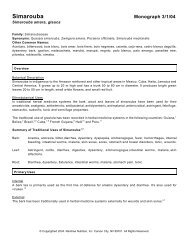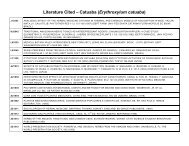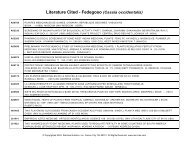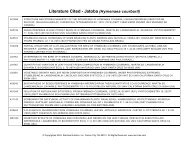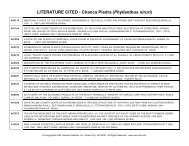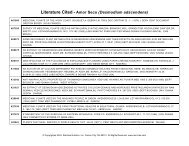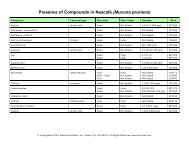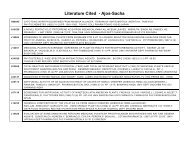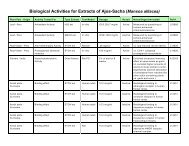Organ Specific Guide - Raintree Nutrition, Inc
Organ Specific Guide - Raintree Nutrition, Inc
Organ Specific Guide - Raintree Nutrition, Inc
You also want an ePaper? Increase the reach of your titles
YUMPU automatically turns print PDFs into web optimized ePapers that Google loves.
AYAPANA EXTRACT<br />
Description: Ayapana is an ornamental erect perennial herb with aromatic leaves that grows 20 to 30 cm<br />
high. Ayapana is native to South America and can be found in the Amazon region of Brazil, Ecuador, Peru,<br />
and the three Guyan as. Ayapana has three different Latin names (Ayapana triplinervis, Eupatorium<br />
ayapana, and E. triplinerve) but all three names refer to the same plant. <strong>Raintree</strong>'s ayapana concentrated<br />
extract uses proprietary extraction methods to concentrate and preserve the active ingredients found in<br />
this rainforest plant. Concentration methods provide the equivalent of 500 milligrams of ayapana per<br />
milliliter of extract. Made with vegetable glycerine and purified water, it contains no alcohol.<br />
Traditional uses by organ or system: Digestion/Elimination: As a stomachic for digestive problems<br />
(nausea, vomiting, stomachaches).<br />
Ingredients: 100% pure ayapana leaves (Ayapana triplinervis) extracted in distilled water and vegetable<br />
glycerine.<br />
Suggested Use: Take 60 drops (2 ml) 2-3 times daily or as needed.<br />
Contraindications: Ayapana leaves contain naturally occurring coumarins. Coumarin has an anticoagulant<br />
and blood thinning effect and is a precursor to coumadin drugs. Those with bleeding disorders<br />
should not take this product and those taking blood thinner medications should be monitored more closely<br />
for this possible effect.<br />
Drug Interactions: Ayapana may enhance or increase the effect of blood-thinning medications.<br />
Other Practitioner Observations and Possible Precautions: None.<br />
Synopsis of research: (Please the online Tropical Plant Database for Ayapana for all cited research.)<br />
In Brazilian herbal medicine systems ayapana is used for queasy stomachs, indigestion, diarrhea,<br />
nausea and vomiting, stomach ulcers, fever, headaches, and insomnia. Ayapana was first written about<br />
in the United States in the American Journal of Pharmacy in 1887 which noted: "The leaves are recommended<br />
against indigestion, pectoral complaints and in cholera, and were used for similar purposes in<br />
Europe in the early part of the present century." Ayapana leaves are also official in the French Pharmacopoeia.<br />
Ayapana is a rich source of naturally occurring coumarin chemicals. Two of ayapana’s coumarin<br />
chemicals are called ayapanin and ayapin which were first discovered in the late 1930's. These chemicals<br />
were reported to have pronounced blood-thinning or anticoagulant actions in four early studies.<br />
In a laboratory study in 1998, a methanol extract of the dried leaves of ayapana did not evidence any<br />
antibacterial activity but did show a weak antifungal activity by researchers in Mauritius. Other researchers<br />
in India working with a pet ether extract of the leaves also reported marginal or no results against various<br />
strains of bacteria and fungi. An ethanol extract of the entire plant (harvested in Surinam) was reported<br />
to be active against Bacillus subtilis at 50 mg/ml but inactive against other bacterial, yeast and fungal<br />
strains tested. Researchers in India reported a weak activity against several fungal strains with the leaf<br />
essential oil.<br />
The essential oil of the flowers has yielded much better antimicrobial results than the plant itself. In<br />
1979, researchers in India reported a strong activity against 10 strains of fungi in vitro using the essential<br />
oil of ayapana flowers. In 1993, the essential oil from the flowers of ayapana was reported to possess<br />
antibacterial (against staph, cholera, pneumonia, and shigella), as well as antiparasitic (Ascaris), and<br />
anthelminitic (Taenia) actions by researchers in India. In an early animal study, the flower essential oil<br />
injected into mice was reported to have CNS depressant, analgesic, and sedative effects (as well as an<br />
in vitro antibacterial effect).



